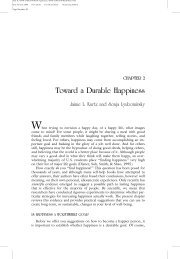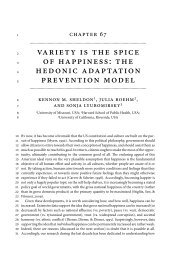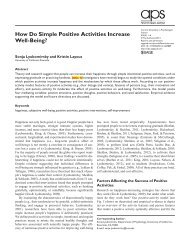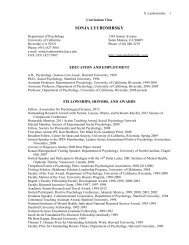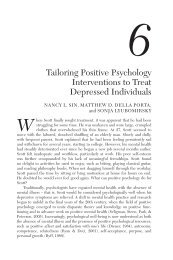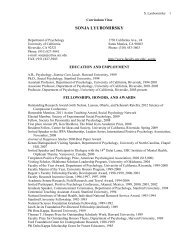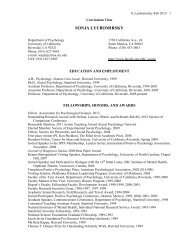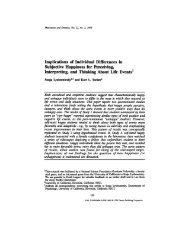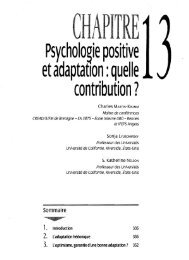Maximizing Versus Satisficing: Happiness Is a Matter of Choice
Maximizing Versus Satisficing: Happiness Is a Matter of Choice
Maximizing Versus Satisficing: Happiness Is a Matter of Choice
Create successful ePaper yourself
Turn your PDF publications into a flip-book with our unique Google optimized e-Paper software.
MAXIMIZING VS. SATISFICING AND WELL-BEING<br />
1189<br />
tion ratings provided the primary dependent variables for both<br />
types <strong>of</strong> analyses. Other types <strong>of</strong> statistical analyses, such as<br />
analyses <strong>of</strong> covariance (ANCOVAs) and repeated measures analyses,<br />
were also performed and yielded results very similar to those<br />
obtained in the analyses reported in this article. For brevity, these<br />
results are not discussed.<br />
Changes in Self-Assessments <strong>of</strong> Ability<br />
We expected maximizers to <strong>of</strong>fer ratings <strong>of</strong> their own ability<br />
that gave considerable weight to social comparison information.<br />
Supporting this prediction, a planned contrast revealed that maximizers<br />
gave lower assessments <strong>of</strong> ability on the anagram task after<br />
working alongside a faster peer (M 1.71, SD 1.27) than<br />
after working alongside a slower peer (M 0.17, SD 1.11), F(1,<br />
50) 10.34, p .003. Self-assessments <strong>of</strong> satisficers, by contrast,<br />
did not differ significantly between the two social comparison<br />
conditions (Ms 0.79 vs. 0.14), F(1, 50) 2.63. The top panel<br />
<strong>of</strong> Figure 1, as well as the top <strong>of</strong> Table 3, shows the mean changes<br />
in self-assessments <strong>of</strong> ability, based on 7-point rating scales, for all<br />
four groups.<br />
As expected, maximizing participants in the “faster peer” condition<br />
not only exhibited the largest relative decline in selfassessments<br />
<strong>of</strong> the four groups, F(1, 50) 11.33, r .43, p <br />
.002, but their mean decline was the only one <strong>of</strong> the four that was<br />
significantly different from zero (M 1.71), t(14) 5.06, p <br />
.001. However, differences between the responses <strong>of</strong> maximizers<br />
and satisficers in this condition—at least in terms <strong>of</strong> changes in<br />
their self-assessments <strong>of</strong> ability—did not reach conventional levels<br />
<strong>of</strong> statistical significance, F(1, 50) 2.73, p .10.<br />
Changes in Self-Reported Affect<br />
Examination <strong>of</strong> changes in participants’ self-reported negative<br />
mood (NA) produced a similar pattern <strong>of</strong> results (see the bottom<br />
panel <strong>of</strong> Figure 1 and the top <strong>of</strong> Table 4). Once again, supporting<br />
our predictions, maximizers displayed significantly more elevated<br />
NA after witnessing a faster peer (M 0.54, SD 0.82) than after<br />
witnessing a slower peer (M 0.03, SD 0.50), F(1, 50) <br />
6.31, p .02. Satisficers, by contrast, showed more similar affect<br />
in response to their superior versus inferior peer’s performance<br />
(Ms 0.12 vs. 0.06), F 1.<br />
Following the pattern <strong>of</strong> results for self-assessments, maximizers<br />
in the “faster peer” condition not only exhibited the biggest<br />
increase in NA <strong>of</strong> the four groups, F(1, 50) 8.70, p .005, but,<br />
once again, their mean increase was the only one <strong>of</strong> the four groups<br />
Figure 1. Changes in assessments <strong>of</strong> ability (top) and negative affect (bottom) after working alongside a slower<br />
versus faster peer (Study 3).



